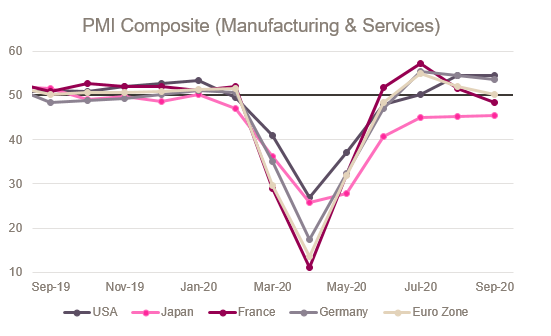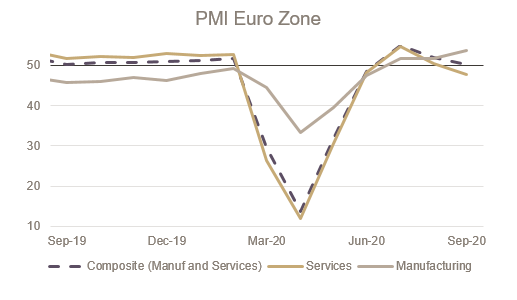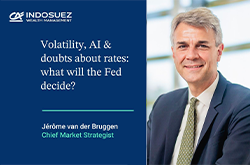Rebound stalls in Europe at the end of the third quarter

Yesterday’s Purchasing Manager’s indices (PMI) showed that the divergence in the recovery from the COVID crisis continues between countries and sectors. Overall, the second wave of coronavirus is weighing on the recovery in Europe’s service sector, while the US has made more solid gains in both manufacturing and services.
Eurozone divergent trends
The Euro Zone PMI Composite index, a weighted average of the manufacturing output index and the services business activity index, slowed to 50.1 (compared to 51.9 in August). Although still signifying an expansion in activity, the index has returned to a 3-month low and disappointed market expectations (consensus: 51.7). This is due to the renewed downturn in the services sector (down to 47.6 from 50.5 in August), especially in France. The increasing number of infections is having an effect, notably in consumer-facing services. Uncertainty remains high for consumers, despite a slight pick-up in the European Commission’s consumer confidence indicator this week (-13.9 to -14.7). Average prices registered by managers in goods and services fell for a seventh month, as firms reported an increase in discount offers to stimulate sales.
By country, German manufacturers led the recovery in September (56.6 compared 52.2 in August) thanks to a solid expansion in export orders (61.1 compared to 55.6). Nevertheless, Germany was not immune to the slowdown in services, as the PMI service index fell below 50 for the first time since May. In France, the recovery in manufacturing (50.9 compared to 49.8 in August) was not robust enough to compensate the contraction in the service sector (47.5 compared to 51.5 in August).
Today’s business sentiment index published by the INSEE painted a relatively similar picture with the recovery in the manufacturing sector outperforming services. The manufacturing confidence index increased to 96 in September (from 92 in August), in line with the consensus. The service sector progressed, but this was due to a progression in manager’s perception of current conditions over the last quarter (returning to their long-term average). Their perception of future activity, however, dropped for a second consecutive month, especially in the hotel/restaurant sector. This last point confirms the likely anticipated risk of a second epidemic wave and does not seem impacted by the announcement of the recovery plan made during the month of these surveys. Another interesting element of this INSEE survey lies in the cyclical reversal indicator, still in positive territory, but a slight deterioration compared to the previous month.
Overall, even if we should be very attentive to the interpretation of the decline in these activity indicators due to the base effects of spring, these elements confirm three points of our scenario:
- A divergence in the strength of the recovery between European countries;
- A weakening of the recovery expected in the 4th quarter;
- A strong sensitivity of the recovery to consumer confidence and the resumption of the epidemic.
The US recovery appears on track
In the United States the story is a little different and a little rosier. Thus far, the recovery appears on track, as the PMI composite index remained in expansionary territory for the third consecutive month (at 54.4 in September). Although losing a little steam compared to the August performance (54.6). Activity expanded in both services and manufacturing (53.5 vs. 53.1), with services only at a slightly weaker pace (54.6 vs. 55). Business expectations moderated amid election and coronavirus disease uncertainty. On the prices front, service managers increased their selling prices steeply in September (the service component of the consumer price index had significantly fallen over the last couple of months).
All in all, amongst other elements, the dollar benefited yesterday from a bout of euro weakness, which probably reflects the decline in confidence in the Euro zone linked to COVID-19 as much as a traditional appreciation of the greenback in the risk aversion phase. The Atlantic divide in the rate of the recovery pushes for additional stimulus support from the ECB especially as the economic surveys did not take into account the new batch of containment measures announced this week.
September 24, 2020






